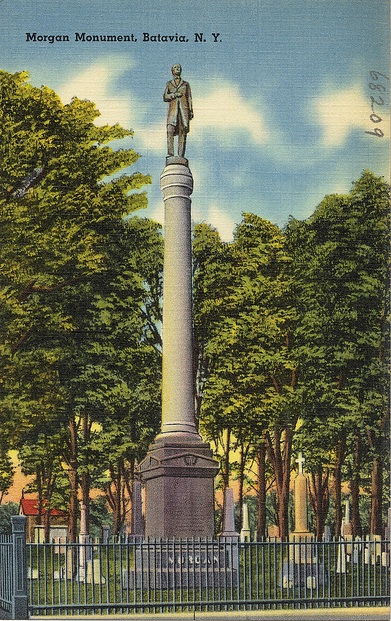4 Wend. (N.Y.) 229
21 AmD 122
3 Wend. 431 (1830)
Juror Disqualification
In 1826, William Morgan of Batavia, New York, wrote a book, Illustrations of Masonry, in which he claimed to reveal the secrets of freemasonry. When David Miller, editor of the Republican Advocate, agreed to print and publish the work, several local freemasons resorted to intimidation. Miller’s printing works were burned and Miller himself was abducted, but later released unharmed. Morgan, however, was kidnapped and never seen again, alive or dead. Word of his abduction spread far and wide, and the Governor issued a proclamation calling for the arrest of those responsible. As time went by and no trace of Morgan was found, Mather and others were charged in connection with his disappearance. When they were acquitted, public outrage mounted and America’s first “third party”, the Anti-Masonic Party, was founded.
Morgan, originally from Virginia and a stone mason by trade, moved to Toronto, Canada and set up a successful brewery. When fire destroyed the brewery, Morgan became impoverished and moved to Rochester, New York where he returned to his trade as a mason. Claiming to have been inducted into the Freemasons in Toronto, he attended a Masonic Lodge in Leroy, New York. He became a Royal Arch Mason and, in 1826, signed a petition to set up a new lodge in Batavia. The masons setting up the Batavia Lodge compiled a second petition that Mather was not given an opportunity to sign. It was the second petition that was submitted to the Grand Chapter, and when the Batavia charter was granted, Morgan found that he was not among the members. Incensed, he began to write a “tell-all” book to which the local freemasons vehemently objected.
The masons commenced a campaign of harassment against Morgan. He was arrested and jailed in Canandaigua on charges of stealing a shirt and cravat, but not long afterwards was released for lack of evidence. He was immediately re-arrested for failure to pay a $2.69 debt to an innkeeper. A couple of nights later, a man appeared at the jail, paid the debt, and had Morgan released but as he was leaving the jail, Morgan was set upon by a number of men and, despite his struggles and cries of “murder,” he was pushed into a waiting carriage, driven off, and never seen again.
Elihu Mather was indicted on charges of conspiracy to kidnap and abduct William Morgan and the case came to trial in November 1829 with Circuit Judge Addison Gardner presiding. The case was prosecuted by a Special Commissioner appointed by the Legislature, John C. Spencer, son of Justice Ambrose Spencer, and Colonel D. D. Barnard was counsel for the defense. The trial lasted ten days and Elihu Mather was acquitted.
During the trial, Commissioner Spencer objected to certain of Judge Gardner’s rulings on juror disqualification and the refusal of a witness to answer a question. At the trial’s conclusion, Spencer moved for a new trial and the motion came before the New York Supreme Court of Judicature in May, 1830.
The Court denied Mr. Spencer’s motion and Justice William Marcy wrote the Court’s opinion in which he stated: The remarks of Ch. J. Marshall in the trial of Burr (Burr’s Trial, 1 vol. 370), are, in my opinion, very judicious. If it be said, he observes, that the juror has made up his opinion, but has not heard the testimony, such an excuse only makes the case worse, for if the man have decided upon insufficient testimony, it manifests a bias that completely disqualifies him for the functions of a juryman. The law, I apprehend, attaches the disqualification to the fact of forming and expressing an opinion, and does not look beyond, to examine the occasion or weigh the evidence on which that opinion is founded.
On the issue of the refusal of a witness to answer a question, Justice Marcy wrote that: The language of Ch. J. Marshall on Burr’s trial is equally explicit on this point. ‘Many links,’ he says, ‘frequently compose that chain of testimony which is necessary to convict an individual of a crime. It appears to the court to be the true sense of the rule, that no witness is compellable to furnish any one of them against himself.
Anti-Masonic sentiment, fueled by the publication of Morgan’s book, Illustrations of Masonry, 1827 and the very light sentences imposed upon those found guilty of his kidnaping, led Thurlow Weed and others to form the Anti-Masonic Party.

